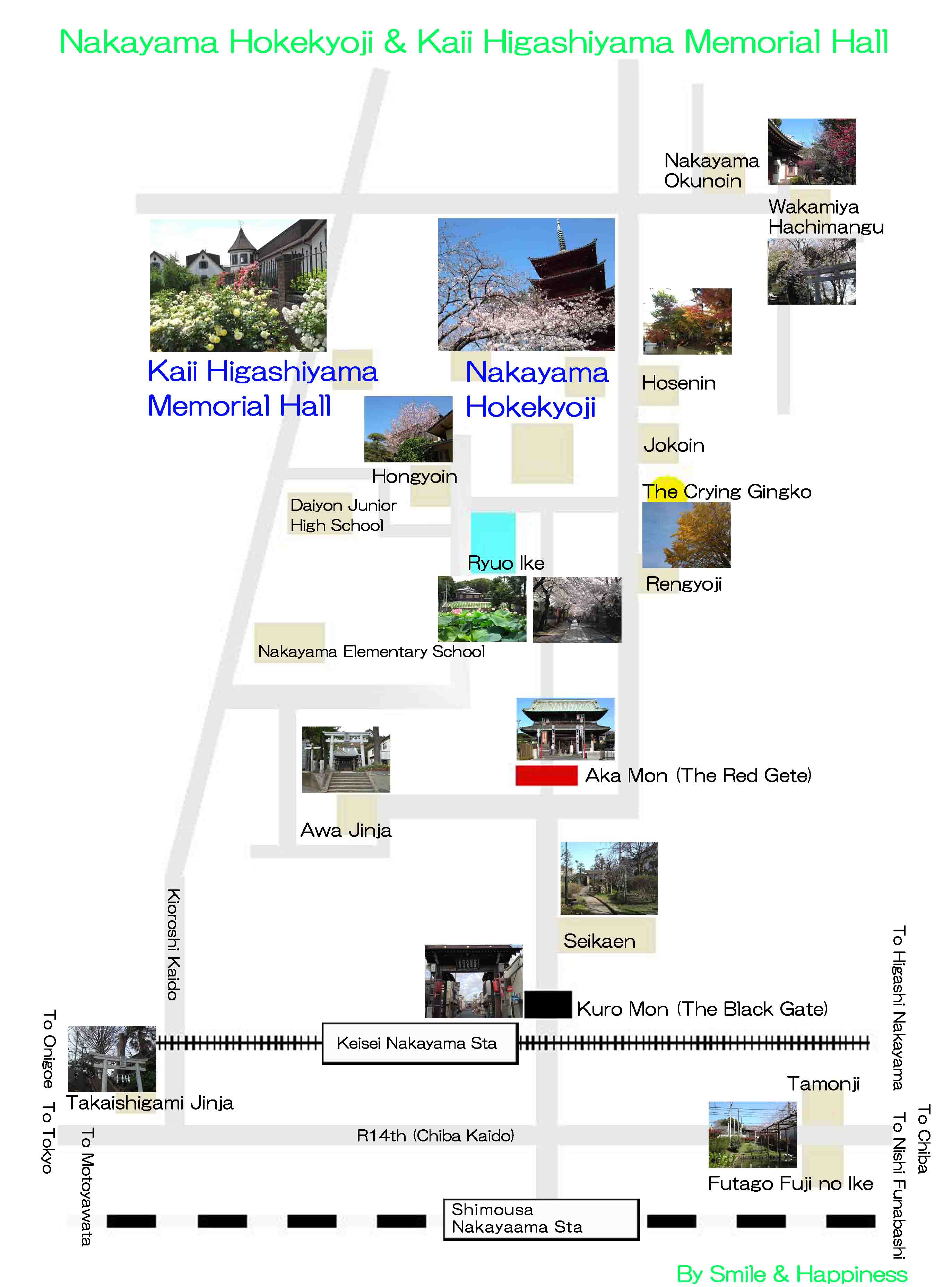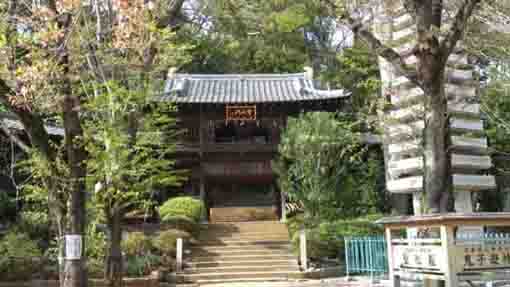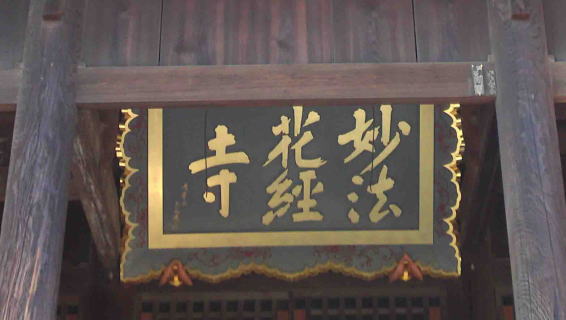Nakayama is in between Narita And Haneda International Airport
<クッキーについての同意並び欧州居住者向けプライバシーポリシー>
中山・下総・散歩道
The Kuro-mon Gate (The Black Gate) In Nakayama Hokekyo-ji

The Kuro-mon Gate ( The Black Gate) And The Framed Letters In Nakayama Hokekyo-ji Temple is designated as the tangible cultural property by Ichikawa city.
The So-mon Gate (The Main Gate) is commonly called the Kuro-mon Gate (The Black Gate), it stands on the approach from Keisai Nakayama Station. Visitors taking off at Shimousa Nakayama Station and Keisei Nakayama Station first pass this gate.
This gate is the So-mon ( the main gate) of Nakayama Hokekyo-ji Temple, but all parts belonged to it was painted in black, then it is called Kuro-mon ( the Black Gate). The date of construction is unknown, maybe it was built the same ages of the Akamon's in early Edo Period.
The architectural structure of the gate is called Korai-mon gate style that is made of two squared main pillars and two round sub pillers, and a thin gabled roof was put on the top of the main pillers, below the rooof, small gabled roofs are put on the main pillars and sub pillars in each. Originally, Korai-mon gate was used in the castles, therefore they usually have doors. But there are no marks that doors put on, therefore it might have had doors since it had been built.
After constructed, it had repaired several times because the sub pillars are earthfast post, then they need to exchang every fifty years, and it also needs to reroof and paint on. The main structure including the main pillars has remained the original style.
Besides the framed letters on the gate was written by Sukenobu Ota, the lord of Kakegawa in 1793. It is also designated as the tangible cultural property by Ichikawa city. The frame was painted and the letters were carved in low relief.
如来滅後
閣浮堤内
本化菩薩
初轉法輪
法華道場
It started frome July of 2009 and spent seventeen months to tear down and repair the Kuro-mon gate. The fudation newly made of concrete, and the sub pillars are exchanged. And the coppers on the roof shingles were changed, then the gate was painted. In addition, the framed letters were fixed.
参考
市川市教育委員会案内板
Sukenobu Ota and Ota Family

Sukenobu Ota and Ota Family
The Ota family is descendant of Seiwa-Ganji Clan, one of the noble family of samurai. The son of Yorimasa Minamoto, Kunitsuna moved to Ota-go, Kuwata-gun, Tanba-no-kuni (West part of kyoto), then the descendant, Sukekuni named Ota, thereafter the family has called Ota. Sukekuni moved to Sagami-no-kuni (southern part of Kanagawa Prefecture), then his son served Ougigayatsu Uesugi Clan (One of the most influential clan to control Kanto region and one of the chief counselors of the shogun) and he built the castle at Kawagoe in Musashi-no-kuni (Kawagoe city, Saitama Prefecture) and controlled the area. Sukekiyo also became the principle retainaer of Ougigayatsu Uesugi and the vice military govenor of Sagami. In the battle of Kyotoku (1455), he fought against Nariuji Ashikaga to guard Akifusa Uesugi. Sukenaga, the son of Sukekiyo, built the castle at Edo (Tokyo), so he is the popular samurai, so called 'Dokan Ota'. He famed in the fought against Kageharua Uesugi in 1476. However, he was assassinated by his master, Sadamasa Uesugi in1486. His son named his direct descendant family Edo Ota Clan, and he based in Edo. In 1524, Suketaka Ota surrendered to Hojo Clan in Odawara (Kanagawa prefecture) and opened Edojo castle. In 1564, Yasusuke Ota set himself against Hojo,but was defeated, then the family were brought to ruin. After that, the descendants of Dokan Ota served Hojo in Odawara, Satomi in Awa-no-kuni (The southern Chiba prefecture)and Satake in Hitachi-no-kuni (Ibaraki prefecture), finally the Ota served Tokugawa Clan, the Edo Bakufu in Edo. The Ota has kept the position of Daimyo (the lord) until Meiji Era, and the family recieved a viscount.Sukenobu Ota (1762-1808) who wrote the framed letters on the Kuro-mon was the third lord of Kakegawa-jo castle in Kakegawa city in Sizuoka prefecture.
参考
デジタル大辞林
明鏡国語辞典
ブリタニカ国際大百科
クロニック戦国全史
The Access to The Kuro-mon Gate In Nakayama Hokekyoji
The Kuro-mon Gate (The Black Gate) In Nakayama Hokekyoji Temple


The map near Hokekyoji and Kaii Higashiyama Memorial Hall
PDF of the map near Hokekyoji and Kaii Higashiyama
The map to the landmarks where Kafu Nagai introduced in his book
PDF of the map of the noted spots where Kafu Nagai visited- Yonsokumon Gate in Nakayama Hokekyouji Temple has great accessibilities from both Narita and Haneda International Airport.
- From Narita International Airport, take Keisei-line and get off Keisei-Nakayama Sta, take minimally 40 minutes from Narita Airport.. And also take JR Sobu-express line, transfer the line at Funabashi to Sobu-Local line, get off Shimousa-Nakayama Sta.
- From Haneda International Airport, take Keikyu-line bound to Narita, and get off Keisei-Nakayama Sta.
- From Tokyo Sta, take Sobu-Express line bound to Chiba or Narita, transfer the line to Sobu-Local line bound to Chiba, Tsudanuma, or Nishi-Funabashi at Ichikawa Sta, get off Shimousa-Nakayama Sta.
- From Akihabara Sta, take Sobu line bound to Chiba, get off Shimousa-Nakayama Sta.
- Take 0 minute walk from Keisei-Nakayama Sta, and take 3 minutes walk from Shimousa-Nakayama Sta.
- 2-10-1 Nakayama, Ichikawa-shi, Chiba-pref, Japan
Sightseeing in Nakayama Shomousa With Mangas
Sightseeing in Nakayama Hokekyoji Temple with Manga (Long Version)
Sightseeing in Nakayama Hokekyoji Temple with Manga (Short Version)
The Landmarks in Nakayama Hokekyouji Temple

Honin(Taikyakuden)・Kishibojindo(Sonshindo)
Takikyakuden is the main hall of Hokekyoji and it has the business office and Kishibojindo Hall dedicated to the goddess of children on the end of the long corrido of the main hall.
The Four Seasons In Hokekyoji
In spring, there is millions of cherry blossoms in Hokekyoji and in summer, lotus blooms on ryuo-ike pond. In fall, there are beautiful colored leaves. Every season, visitors could enjoy seeing the sights.
Soshido(Daido), the nationally important cultural property
It is characterized the twin hip-and-gable roof structure (hiyoku-irimoya-style), and hengaku written by Koetsu Honami hangs in front.
Goju-no-to (the five-story pagoda) , the nationally important cultural property
It was built in early Edo period (1622) by request of Koshitsu Honami supported by Maeda Family in Kaga.
Hokke-do(the nationally important cultural property)
It was built in Kamakura period.
Yon-soku-mon (the nationally important cultural property)
It was moved from Aizen-dou in Kamakura 700 years ago.
Shougyoden (the treasure hall)
It was designed by the famous architect Chuta Ito, it stores many scripts written by the Founder Nichiren.
Shogan-jyoujyu-kigan-do (kiyomasa-kou-dai-zingi-do)
It enshrines Kiyomasa Kato, one of the most famous daimyo in Sengoku period.
Aragyodo Hall (the hall where Buddhiist priests practice for 100 days in winter severly)
From Nov 1 to Feb 10, hundreds of Buddhist priests practice severly every year.
The Nio-mon Gate (The Deva Gate)
The henguku hunged in front of the gate was written by Koetsu Honami, famous artist in Momoyama Period.
Setsu-do
It was built for worshipping Jurasetsunyo, Kishibozin, Daikokusama.
Black Gate(a tangible cultural asset by Ichikawa City)
It is also called Sou-mon (the main gate).
Hachidai-ryuo-do
The founder Nichiren built the small shrine to dedicate the dragon god to pray for rain.
Ugazin-do
It enshrins Ugazin who is the guardian deity of Hokekyou-ji Temple.
Myouken-do
It dedicates Hokushin Myouken Star that the Chiba Family deeply believed in, Hokekyoji traditionally succeeds. In November, Tori-no-ich is held in the site to dedicate the star.
Oku-no-in (the first place where Nichren had preached at)
The founder Nichiren preached first time at the Toki's castle called Wkakamiya Yakata. And Toki built a temple 'Hokkeji', it is the origin of Oku no In.
The Great Buddha(The Seated Statue of Shaka Nyorai)
It was built in 1719 by famous caster Ota Suruga-no-kami in Kanda. It is the bigest great Buddha in Chiba prefecture.
The statue of Nichijo and Naki-Icho
Nichijo was the first abbot of Nakayama Hokekyoji Temple and Naki Icho is a gingko tree having a sad legend.
Kagami-ike-ato (the remain of the pond like a mirror), Emado hall, Hoden-mon gate, Ryuenkyo bridge
There are some other landmarks in Nakayama Hokekyoji Temple.
The artists, poets and writers related to Hokekyoji Temple
Koetsu Honami specially remained his calligraphy in Hokekyo-ji Temple, and Shiki Masaoka, Kafu Nagai discribed it well.
The Tacchu Temples and the Branch Temples in and around Nakayama Hokekyoji Temple
Some tacchue temples are introduced in this page.
A Walk on the the area around Nakayama Hokekyoji Temple
There are some noted spots, Kaii Higashiyama Memorial Hall and so on, near Hokekyoji.
The Popular Viewing Sakura Spot / Nakayama Hokekyoji Temple
Cherry blossoms in Hokekyoji are amazingly wonderful.- 広告 Advertisement -
